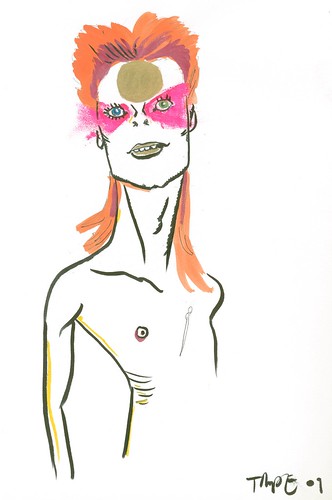Archive for December 15, 2009
Carnival of souls
December 15, 2009* Founder of the mighty Fluxblog and friend of ADDTF Matthew Perpetua will be giving a lecture on Wolverine as part of NYC Nerd Nite at Galapagos in Brooklyn this Thursday evening at 8pm. I highly suggest you attend if you are a nerd. Here’s the scoop:
Learn how The X-Men’s Wolverine has evolved over the course of the past four decades and what each version of him says about both the people working with the character and the way audiences respond to variations of the same masculine fantasy. More so than most other superheroes, Wolverine has a particular appeal to insecure young men as demonstrated in overcompensation involved with the character, to subtle aspect such as how large people draw his claws…
If that doesn’t sound like a fine way to spend your Thursday evening then motherfucker I don’t know what to tell you. Buy tickets here.
* Is it just me or are a lot of altcomix heavy hitters doing webcomics lately? After yesterday’s powerhouse Huizenga/Rickheit/Nilsen trifecta, today you’ve got new comics at Vice from Sammy Harkham, Dash Shaw, and Johnny Ryan, plus my favorite installment so far in Nick Bertozzi’s long-running series of bizarre little captioned illustrations.

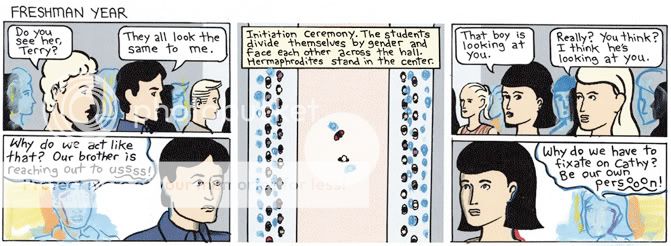


(Mostly via Spurge.)
* Frank Miller’s working on a graphic-novel prequel to 300 about the Battle of Marathon called Xerxes. Bring it on!
* Tom Neely’s selling those gawjuss horror covers he did. In the words of the Emperor, “You…want…this…don’t you?”
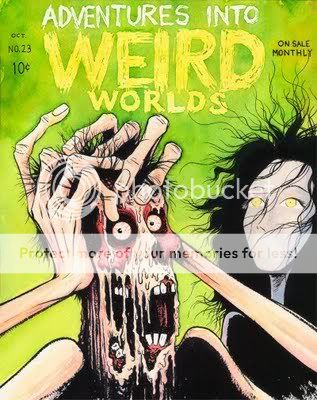
* Ben Jones profiled in The New York Times. That’s just wonderful. (Via everyone.)
* If I were President Lieberman I’d give Gilbert Hernandez a $50,000 grant every day!
* Five years and 2,000 pages of MOME! Congratulations to Eric Reynolds, Gary Groth, and the many contributors–that’s a real accomplishment, and MOME has provided me with a lot of enjoyment and food for thought over those years.
* Brandon at Are You a Serious Comic Book Reader? is right, and actually righter than he admits to being, in the aforelinked piece about how constant cliffhanger endings really fuck up the rhythm of 22-page serialized comics. They look lovely and read well but how I wish Sweet Tooth and Daytripper were graphic novels.
* Another piece of the Frank Santoro puzzle falls into place.
* Look at the bait-and-switch shit Marvel used to pull by hinting Wolverine would be in a comic in the ’90s. (Scroll down to the last cover.) Outrageous! Thank you, Cool Kids Table, the people need to KNOW.
* Meanwhile I screwed up my earlier link to the CKT’s Nova cover gallery so here it is again. And here’s the first installment in what augurs to be a lovely series of posts in which the CKT crew recalls comics that meant a lot to them for each year of the decade.
Carnival of souls
December 14, 2009* I don’t care how much Joe Lieberman makes America his Snooki in the Jersey Shore reenactment that is his horrid, horrid life–any day with new webcomics by Kevin Huizenga, Hans Rickheit, and Anders Nilsen is a pretty good day.
* Matt Fraction and John Romita Jr. on Thor sounds pretty great.
* Jog does another one of those picaresque con reports/here are some other books he bought at or near or while thinking about the con reports/here’s a conversation he had with Tucker Stone reports he specializes in, this one loosely centered around the Brooklyn Comics and Graphics Festival.
* Wow, the writer’s bible for Batman: The Animated Series. I think virtually every week I worked at Wizard, when we’d go out to lunch at the Palisades Mall, I’d go into Best Buy and just stand there and covet the DVD box sets for that show. At one point I think I bought them but returned them the next day because I realized I wouldn’t get a lot of re-watching out of them. But for a long time, that was my favorite ongoing interaction with my favorite superhero.
* Matt Maxwell holds grudges against video-game enemies in World of Warcraft. I like that about him.
* Today on Robot 6: Wizard might be relaunching its website, The Comics Journal maybe needs to revamp its relaunch, San Diego tickets go on sale tomorrow, here’s a goofy Alan Moore photoshop, and here are some cool TV posters.

* Seriously, the new TCJ.com is pretty bad. Someone tell Gary Groth he can’t win just by showing up anymore.
Comics Time: City-Hunter Magazine #1
December 14, 2009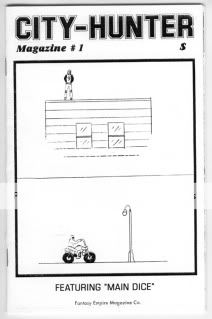
City-Hunter Magazine #1
C.F., writer/artist
Fantasy Empire Magazine Co., December 2009
20 pages
$3, I believe
I have no way of contextualizing this thing. It’s not Powr Mastrs, it’s not even a smaller and stranger but still-quite-obviously-a-minicomic minicomic like Core of Caligula. It’s billed as a “zine,” and there’s a comics sequence, yeah, but it’s mostly illustrations and sketches and doodles and a couple of goofy prose pages and a blown-up xerox of a piece of an issue of USA Today. As such? I still really enjoyed it. C.F. gains more from inscrutability than just about any other working cartoonist; at its best his stuff already has an air of mystery to it, so when stripped even from the relatively loose standards of his “proper” comics, the way he writes out phrases like “MANSION SOFT DRINK” scribbles them out, writes them over again, and follows them up with a stand-alone image of a person walking past a fancy-looking window toward a soda machine, say, takes on a whole new weight. Who the hell is “LUCIO” and why is his name taking up half a page? What does any of it have to do with those rather sexy bondage pin-ups–one of them in full color? Beats me, and that’s quite fine.
The things I could make sense of tickled me, at any rate. The titular strip, set up with a prose introduction by “editor” “Mike Rennet” (does he exist? does it matter?) about the need he felt to discover the big city when he moved to it, follows around a little dude in a memorably C.F.-ian jumpsuit as he walks around the city and just stand around in various places. It’s kind of Pythonesque in its vibe, though I’m finding it difficult to convey. All I know is that I laughed. Same with the second text piece, an editorial from Rennet about how if you live in the city you have to live it up:
Now if you’re reading this thinking I’m standing still in my own poison, mortified by my past and terrified of my future, you’ve got another thing coming. And that thing is my scared, angry fist, smashing through your apartment wall. Your messy, overpriced, uncool, apartment… wall. You’re going to shrivel up; because you don’t know anything about how to work this city, man.
It ends with an exhortation to check out the author’s Facebook page. I got my $3 worth out of this and that’s all the context I need.
Carnival of souls
December 11, 2009* Today on Robot 6: Scott Allie talks horror and Tom Brevoort talks trash.
* Tom Spurgeon talks to organizer Gabe Fowler about last weekend’s very awesome Brooklyn Comics and Graphics Festival. Then he reviews Tales Designed to Thrizzle.
* Benjamin Marra tells his side of the Bowie Sketchbook story.
* Matt Maxwell reminisces over WoW, for real.
* Nova connoisseur Ben Morse presents his favorite Nova covers.
* Is this Jim Woodring’s best drawing ever?
Comics Time: A Drifting Life
December 11, 2009
A Drifting Life
Yoshihiro Tatsumi, writer/artist
Drawn & Quarterly, 2009
856 pages
$29.95
I have a friend from college who every time I talk to him we’ll just end up talking about comics and music and movies, and then I’ll hang up and my wife will be like “Did you tell him about our new house?” or “I saw on his girlfriend’s LiveJournal they got a new dog?” and I’ll just have to shrug my shoulders, because there was no way we could fit topics like that into our discussion of Dragon Head or John Romita Jr. or whatever. This massive autobiography is like that: It’s about the joys of pure unabashed obsessive nerdery, the almost physical pleasure of talking and thinking and writing about and working on nothing but the art you enjoy. That makes it an easy book to like. So does Tatsumi’s appealingly simple and direct art, which like a McCloud thesis in action presents Tatsumi and a galaxy of manga-pioneering stars as lovable little caricatures you never get sick of watching and rooting for. And so does the history lesson about the Japanese comics industry that it inevitably teaches. Comics as a mass medium, comics as a legitimate art form, book-format comics, comics in a variety of genres for a variety of age groups and interests–nearly everything the American comics industry is only now achieving, and in some cases may actually never achieve, Japanese comics had already done decades ago. It’s like if we’d fought World War II against Hicksville.
The thing is, much of what makes it such an easy book to like also makes it a hard book to love. Tatsumi’s relentless focus on manga, its omnipresence as the focalizing device for the story, left me scratching my head about whether other aspects of his life really did intrude upon his writing and drawing as perfunctorily as he shows them doing here. I mean, just as an example, was this dude really that uninterested in getting laid throughout his teens and early 20s? There are of course a couple of nods in that direction but they just make the relative absence all the more conspicuous. Early in the book his family plays a larger role, which makes sense because he lives with them. But his brother (and frequent coworker and collaborator)’s illness, his parents’ loveless marriage, his father’s ne’er-do-welling–did they just go away?
What’s more, the book is more about the business of manga, and making a living in it, than it is about the art itself. For every page-long disquisition about the nature of the mature “gekiga” style of comics storytelling Tatsumi helped pioneer, there are dozens about catching a train to drop a manuscript off so that he can collect a paycheck from a publisher before they declare bankruptcy or whatever. That sort of thing is a lot of fun, don’t get me wrong–when I wrote my oral history of Marvel Comics I could have sat in Joe Simon’s apartment and listened to him ramble about him and Jack Kirby fighting with Martin Goodman for hours–but it’s not going to have the impact that really digging into what made young Tatsumi tick as an artist could have had.
Indeed, the book just picks up with li’l Tatsumi already a hardcore manga fan. We never learn what hooked him to begin with, and that’s an absence that’s reflected, in its way, right up until the end: The story cuts off abruptly as Tatsumi, literally swept into a violent protest against the government by a surging crowd, connects the anger of the protesters to the ingredient he’d felt had gone missing from his own work. I assume this was the last moment Tatsumi doubted his career path? Or perhaps it was the last moment he felt blocked as a writer or artist? It’s not clear why after 800-odd pages, this is where it all ends. Like the action kicking off in medias res in terms of Tatsumi’s love of manga, it’s an odd lacuna.
One of the insights we really do get into Tatsumi’s gekiga is that it’s intended as a type of minimalism, a sort of off-kilter spareness traceable to cinema and hardboiled American detective fiction. (Its lack of text made it an easy target for bluenoses, who said that any comics page that was two-thirds wordless or more was automatically immoral.) And the book’s definitely economical in the sense that it’s a no-nonsense flow of images and text smoothly propelling us from one thing to the next as Tatsumi’s career progresses. But the constant narration rarely gives story or reader a moment’s pause. Couple it with the “on this day in history”-type panels featuring highlights from Japan’s cultural and political evolution during this time, and it’s easy to feel like you’re skimming a life rather than drifting through one. (Which reminds me, if this is what passes for A Drifting Life for Tatsumi, whose sole, laser-like focus throughout is drawing manga for a living and who busts his ass day after day and year after year to make it happen, I’d hate to think what he’d make of me!)
I think A Drifting Life is a fine book. (I definitely like it a lot more than the kind of ham-handed violent O. Henry short stories I’ve read by him.) Reading it is a lot like plowing through a long run of a serialized comic in one go: It’s a delicious, I wanna say tactile experience, and the subject matter guarantees it’s time well spent if you love comics enough to read a blog like this one. You’ll recognize a lot of yourself in it. But I suspect that that recognition comes at the expense of revelation.
Who will love a David Bowie sketchbook?
December 10, 2009I’ve posted the latest round of David Bowie sketches I snagged at SPX and Brooklyn on Robot 6. You can see the sketches from all 80 artists in my Flickr set too. That’s Tunde Adebimpe above. Enjoy!
Comics Time: B.P.R.D.: War on Frogs #4
December 9, 2009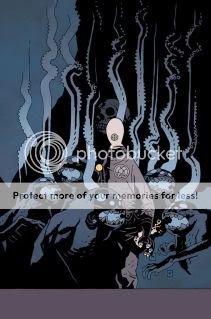
B.P.R.D.: War on Frogs #4
John Arcudi, writer
Peter Snejbjerg, artist
Dark Horse, December 2009
32 pages
$2.99
I never thought I’d see the day where I’d be happy that Dave Stewart didn’t color a Hellboyverse book. But on this New Comics Wednesday, the best colorist in the front of Previews finds himself stranded in Brown Town in the pages of Fabio Moon and Gabriel Ba’s Vertigo series debut Daytripper. And he’s left colorist Bjarne Hansen to absolutely kill it in conjunction with artist Peter Snejbjerg in this concluding issue of the gap-filling series of glorified BPRD one-shots. Generally he hews close to Stewart’s long-established palette of full blues, reds, and greens, designed to contrast against the usual washes of black (and if I’m not mistaken derived from Matt Hollingsworth’s work in the initial Hellboy miniseries). But in the issue’s spectacular climax, he adds flourescents that wouldn’t look out of place in Tron; it’s something we’ve never seen before in Mignola World, and the effect is a stunning way to suggest the Otherness of what we’re looking at. Further, Snejbjerg’s art, already a winning riff on Guy Davis’s model that smoothes out some of the rough edges in favor of a wispy vulnerability, is put through a focus-blurring filter, as if poor Johann Kraus’s view of the next world literally can’t be visually comprehended. It’s a lovely, clever, and chilling way to drive home the story by John Arcudi, which is yet another tale of one of our ostensible heroes realizing he’s in way, way over his head but continuing to struggle simply because the alternative is unbearable to contemplate. The quality control for this ever-expanding franchise during the course of this decade is one of contemporary genre comics’ minor miracles, and this issue is a happy example, and by happy I of course mean melancholy and pessimistic as Hell.
Carnival of souls
December 9, 2009* Today on Robot 6 I called out McSweeney’s awesome-looking San Francisco Panorama and Dylan Pommer’s awesome-looking Immortal Weapons custom action figures.
* Mystery Science Theater 3000 is on Hulu! (Via Mark Coale.)
* Grant Morrison Batman news galore today: He’s doing a miniseries called The Return of Bruce Wayne that chronicles the character’s battle through the timestream to return to the present day. He’ll be a caveman and a pirate and a cowboy and a Victorian-era guy and a noir private dick, apparently. No complaints. Each issue will be drawn by a different artist–let’s just hope Philip Tan’s off the table. Here’s a USA Today interview with Morrison featuring all of the usual Morrison-interview antics.
* Also, Andy Clarke has been announced as the next Batman & Robin artist after Cameron Stewart. The sample art looks lovely, certainly a better fit than you know who as far as dudes drafted to work on the book with no history of collaboration with Morrison go. There are actually quite a few very impressive artists at DC right now, but they tend to be squirreled away in unlikely places: Clarke had been toiling on the little-read series R.E.B.E.L.S., while today I was once again knocked out by the art of Cafu…who’s doing the Captain Atom back-up stories in the apparently not very popular Superman-less Action Comics (which like the whole Superman line is actually quite enjoyable!).
* More BCGF con reports, from Frank Santoro and Jessica Campbell. This thing was a hit. And the lack of junk stood out even among the likes of SPX and MoCCA.
* I really love Fantagraphics’ trade dress for its Jacques Tardi releases.
* Matt Maxwell continues his look back at World of Warcraft with a you-are-there reminiscence about the very, very, very earliest days of the game, back when there was exactly one city to explore. If you were a fan of Bruce Baugh’s writings on the game, you wanna be reading this.
* Speaking of WoW, via Ceri B. comes another WoW trailer, this one for Fall of the Lich King Patch 3.3, that will, provided you have fantasy-geek buttons, hit them like fucking Mjolnir.
* The 100 Other Greatest Quotes from The Wire, spoilery as, well, fuck.
* Lady GaGa in an Elizabethan red vinyl costume playing on a Cloverfield monster piano? Sure, I’ll eat it.
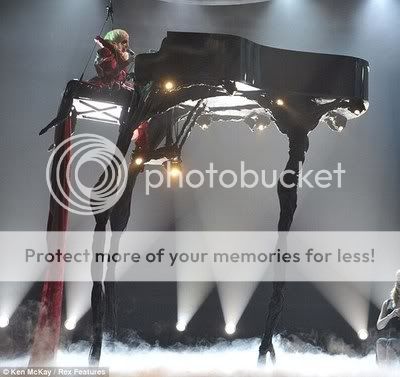
Gossip Girl thoughts
December 9, 2009* Wolves?
* Lily’s annoyed that Rufus loves their family so much. So awesome.
* Chuck Bass knows damn well when his father died. He goes down to Crime Alley and lays flowers on the spot where he was murdered every year. Plus he swore a solemn vow and everything.
* Nate being Common Sense Man is a lot of fun. His reaction shots are becoming a quiet highlight of the show.
* Rufus is a Lady Who Lunches! Hahahahaha
* Chappaquiddick!
* Drama Girl is cute, but that top! Ugh, awful.
* Who refers to Nassau County as a destination? “Take me to the Town of Oyster Bay!” Also there’s not really a Nassau County Sheriff in the traditional sense.
* LOL Dan Humphrey: “Sorry, Vanessa, I’m probably just upset over my sister who I lost my virginity to getting in a car accident. I don’t know what came over me.”
* Haha, Rufus is creepin’! The Ruf is on fire!
* Let’s get as many David Lynch cast members into Gossip Girl as possible. Paging Grace Zabriskie!
Carnival of souls–Special “This Was Supposed To Go Up Yesterday, WTF” Edition
December 8, 2009* So I made it to the Brooklyn Comics and Graphics Festival after all! I wrote a lengthy con report for Robot 6. It was a pretty terrific show, and being able to swoop in and out with a round-trip travel time that isn’t a whole lot longer than going to visit my mom when it’s trafficky out made it even better. Read the report, and then also read Heidi MacDonald and Rickey Purdin‘s reports, and check out Heidi’s photo parade. Meanwhile, con organizer challenges Heidi’s characterization of the show as not being the progeny of Jack Kirby. Interestingly, he says the organizers reached out to “mainstream” artists in vain. Jesus, can you imagine if they persuaded John Romita Jr. to show up? He’d be greeted like a god-king.
* I put together an alt-horror update for Robot 6 that tracks recent developments in the worlds of Renee French, Hans Rickheit, Tom Neely, Benjamin Marra, Al Columbia, and Josh Simmons.
* Speaking of Simmons, Tom Spurgeon reviews Cockbone, a real comic-of-the-year contender.
* Hey look Marvel.com re-released my interview with Paul Pope about his Strange Tales contribution.
* Tucker Stone reviews the decade in comics so we don’t have to. Seriously, his capsule characterization of the fates and fortunes of each of North American comics’ many branches is masterful. Great ending, too. A must-read, dare I say it.
* Am I the only one who forgot Dan Clowes is being published by Drawn & Quarterly now?
* Oh crap new Kevin Huizenga strip, with words, in English and everything.
* And here’s the complete Kevin Huizenga/Art Spiegelman interview from The Comics Journal #300. Man I didn’t even have close to enough time to read that today–it’s long!
* DC is sort of doing Ultimate Batman and Ultimate Superman series in graphic-novel format. That’s pretty interesting, but the main thing that’s interesting about this to me is Geoff Johns and Gary Frank doing Batman. I have no idea what a Geoff Johns Batman would read like, though I’m reasonably certain a Gary Frank Batman will look awesome. AICN’s Ambush Bug talks to Johns and Superman writer J. Michael Straczynski. Heck, I’m even a bit intrigued about JMS’s end of things.
* Eli Roth’s still talking about his giant robot movie. We’ll see.
* Matt Maxwell says goodbye to World of Warcraft in part one of what augurs to be a genuinely epic series of posts (if his con reports are any indication). Matt has been playing WoW since it was in alpha, and his history lesson is delightful for an outsider like me.
* Bookmarked for later reading: Jason Adams reviews [REC]2. It’s amazing what a formula these sequels have, huh?
* Sean “Strange Ink” Belcher’s Top 100 Films of the Decade. Fuck yeah The Lord of the Rings.
* Real Life Horror: Remember those three prisoners who coordinated their suicides at Guantanamo Bay? Looks like we straight-up fucking murdered them. Ever feel like that kid at the end of Stephen King’s “The Jaunt”?
Carnival of souls
December 8, 2009* Today on Robot 6 I tipped my hat to Tucker Stone’s decade in review column and Ben Herman’s Beautiful Dreamer sketchbook.
* DC’s next big event is called War of the Supermen. Thoughts:
1) Another “War”! Civil War, Silent War, World War Hulk, War of Kings, The Sinestro Corps War, the “War of Light” meta-story in Green Lantern and Blackest Night, the Invincible War and Viltrumite War in Invincible, and there’s surely more I’m missing.
2) I like J.G. Jones, but, um…
3) This event seems to be patterned after the way Blackest Night, a line-wide event, spun out of Green Lantern‘s Sinestro Corps War, a franchise-based event. The difference, though, is that Sinestro Corps War was hugely popular, whereas I seem to be one of very few people who are following and enjoying the whole New Krypton/World Without a Superman mega-story.
4) The last line here made me laugh pretty hard.
* Frank Santoro presents his haul from the Brooklyn Comics and Graphics Festival.
* Jeez, look at the lighting in this piece by Richard Corben. It’s so realistic I thought I was looking at a photograph of a sculpture, I swear.
* Today’s Strange Tales Spotlight re-run is John Leavitt.
Fire out
December 8, 2009The first few minutes of The Road, director John Hillcoat’s adaptation of Cormac McCarthy’s relentlessly bleak post-apocalyptic novel, tell you pretty much everything you need to know about the rest of the movie. A handful of stand-alone shots metonymize everything the world is about to lose: pretty pink flowers, a soulful-eyed horse. (Viggo Mortensen really has a way with horses on camera.) It’s manipulative and obvious, I suppose, but it works. Then the mysterious disaster occurs, and before we cut to the opening titles we hear the most memorable lines from the book as Mortensen’s nameless protagonist quickly fills his tub with water while his nameless wife looks on: “Why are you taking a bath?” “I’m not.” Man was I ever stunned and devastated by that line when I first read it; launching the movie with it is super-smart. Finally we get to the main business of a man and his son trudging through the ruined world, and as Mortensen’s narration kicks in, it’s almost difficult to believe how careworn and ground down he sounds. Every line is delivered like he’s been on the receiving end of days’ worth of beatings attempting to extract information he’s told us a thousand times he doesn’t have. We see his craggy, scraggly face, his mouth set with a skull’s teeth, and it’s like if Aragorn were wandering around without hope in a world where Sauron got the Ring back. But then you notice the utterly conventional score by Bad Seeds Nick Cave and Warren Ellis, and it’s like ugh, Oscar bait, thanks for playing, goodnight.
Aside from the overscoring and one sequence of bogus suspense involving a then-faceless antagonist that’s shot like something out of a Lifetime movie, there’s nothing bad about The Road. But aside from Mortensen, and a series of holy-shit casting decisions that end up giving us a World Tour of Wonderful Actors from the Great HBO Dramas of the ’00s, there’s nothing about it that feels essential, either. The Tracker-esque ruin and squalor is shifted into that slightly bluish prestige-movie color palette. Charlize Theron’s role is nowhere near as beefed up as rumor had it but nor does it do much but establish that there’s a gorgeous blonde movie star who can also act in the movie (I didn’t buy her fate at all, particularly compared to Mortensen’s reaction to it at the moment and remembrances of it in the future). The moments of horror are kind of expected and bland, except for a couple toward the end that are combined with pathos. And throughout, that score, telling us exactly how to feel at any given moment. I kept imagining the movie without music, like the Coen Brothers’ McCarthy adaptation No Country for Old Men–everything would have improved like (snap) that.
But this film lacked that film’s confidence, both in itself and in its audience. Which I sort of understand. I mean, the subject matter here is even more brutal, which the film does a good job of establishing through intermittent scenes of the Man’s casualness about exposing the Boy to dead bodies. Life has really broken down, and I appreciate the need to give us some outs to dealing with that now and then. In fact I actually applaud the film’s elision of two of the book’s most difficult scenes, involving a dog and a baby; I spent the movie dreading them, simply unsure if I’d be able to take them, and I fortunately didn’t have to. (This also set up a pretty terrific final couple of shots.) Still, on the level of the look and sound of the thing, I was just getting too much reassurance, reassurance that I was watching a motion picture that would address, in ultimately satisfactory fashion, the big questions. The movie seemed to see its job as one of softening the blow. Even though I’m getting to the point (as I realized throughout the screening) where I sort of feel like something’s gotta give with my whole constant rubbing-my-face-in-life’s-ceaseless-awfulness thing, I don’t think that satisfaction was what I was looking for.
Comics Time: Multiforce
December 7, 2009
Multiforce
Mat Brinkman, writer/artist
PictureBox, 2009
22 pages
$15
We tend to think of the breakdown of civilization as a rather stark affair. Things fall apart, the center cannot hold, and before long everything’s a burnt-out husk and people in rags and/or leather underpants are scavenging the wasteland for canned peaches and guzzoline. In keeping with Fort Thunder’s general aesthetic project of information overload, Multiforce imagines the contrary: a replete Ragnarok, a jam-packed apocalypse.
A loosely linked narrative about the warring citizens of a massive mountain redoubt called Citadel City and the even stranger places above and below it, Multiforce‘s serialized strips (they originally appeared in Providence’s visual-noise bible Paper Rodeo) concern themselves primarily with bigness. A giant meets an even bigger giant, who meets an even bigger dragon; little dudes ride around inside the head of a huge dude; skeletal characters dwell in structures and even cities that are shaped like their own skulls, suggesting a preexisting being of almost unimaginable proportions. Half of the book’s narrative juice comes simply from stringing the book’s two protagonists (and the reader) along until the next massive step-up in scale can be revealed. It’s like the comics equivalent of a zoom-out, only suggested through sequential juxtaposition rather than an actual ratcheting back of the viewing plane (that actual technique is seldom if ever used here, to the best of my recollection).
The creatures, which are as gorgeous and inventive and inner-eight-year-old awesome as you’d expect from the product of a man who nowadays makes a living by creating prints of demons and shit, are a constant game of one-upsmanship as well. Brinkman lays this out in an introductory strip, in which we watch a monstrous character who’s super-proud of his awesomely dangerous bionic arm–“I HAVE THE MOST ULTRA ARM IN THE UNIVERSE”–promptly get his clock cleaned by the book’s main, inscrutable antagonist, Battlemax Ace. He’s a battle beast with an axe for one hand and a mace for the other. Yeah, it’s that kinda book. And it’s Battlemax Ace’s unstoppable rampage that brings Citadel City crashing down and provides one of the book’s few genuine narrative and logistical throughlines as he smashes his way through opponent after opponent and level after level. His awesomeness is too powerful to contain.
In many ways these beasties and their navigation of craggy subterranean spaces recalls Brinkman’s landmark collection Teratoid Heights, but that book’s wordless fervor gives way to Brinkman’s loosey-goosey verbal hijinx–his characters bumble around and talk smack like a crudely lettered cross between the Muppets and the stars of a stoner comedy. So the moments of sheer visual poetry stand out in even starker relief–our heroes flying in a sinuous, continuous curve through a Marc Bell riot of a carnival; a dropped head bouncing and rolling down a massive page-tall mountainside; the aforementioned giant skull. But the main takeaway is a set of civilizations so obliviously concerned with their own business and jaded about their potential annihilation that they’re all pretty much fiddling as Citadel City and its environs burn (and explode and implode and collapse and cave in and get smashed by Battlemax Ace and so on). Our heroes even leaven their soaring last-page getaway with a snort of “yea right.” One, two, three, what are they fightin’ for? Don’t ask ’em, they don’t give a damn.
Carnival of souls
December 4, 2009* Now this is a treat, film lovers: The great critic Matt Zoller Seitz elucidates the greatness of the great critics David Bordwell and Kristin Thompson, declaring them The Critics of the ’00s on IFC.com. My feelings about Seitz are no secrets, and like many film students I’ll never forget the way Bordwell & Thompson gave me the vocabulary I needed to articulate things I’d always known but could never say about cinema. I may have forgotten many of those words since then, like I’ve lost my French, but I won’t forget that I knew them.
Digression: In writing about film for this blog I’ve noticed that I don’t talk about form the way I do with comics. Like I said, I’ve lost a lot of that vocabulary, which in turn limits my ability to think that way, and that’s really sad. When I first started regularly reviewing comics–probably for The Comics Journal–it took a shot by Milo George at the state of comics criticism to make me realize that I was doing the usual formula: Three or four paragraphs about the writing, one paragraph about the art, a “to be sure” paragraph, and a conclusion. Figuring out that comics are a visual medium ain’t rocket science, so to confer upon myself a rocket-science degree if you will, I tried to fix this the easiest way I could: I began forcing myself to start reviews by talking about the visual aspects of the comics. Eventually it got to the point where I was comfortable and conversant in that area, so now I feel like I don’t have to make myself do that anymore. I’ll start wherever I feel it makes the most sense to start. When I wrote my review of A Serious Man the other day…well, I’m pretty happy with it, but it occurred to me maybe it’s time to start writing about form first. Of course this is harder with movies you’re seeing in the theater, since you don’t have them in front of you to flip through, and until I’m a paid film critic there’s no way I’m taking notes at a movie theater, man.
* Today at Robot 6: Hot deals from Drawn & Quarterly and hot art from Cameron Stewart and a Hellboy art show by The Autumn Society.

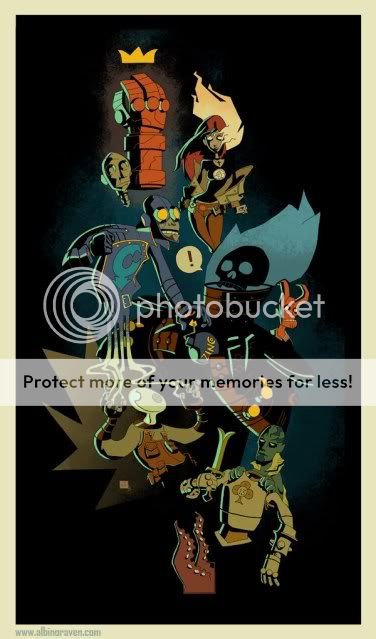
* That Kentucky library that fired a couple of employees for improvised censorship of Alan Moore & Kevin O’Neill’s Black Dossier is moving relevant graphic novels to the adult section. Which is where a lot of them probably belong, so that’s fine. It just really grinds my gears that a couple of bluenoses took it upon themselves to remove books from a library that they worked for. Barbarians at the gates.
* Hurm.
* I’m a little hesitant to draw attention to this eBay auction for a bunch of zines by Josh Simmons and some other people because I want them, but in the words of Godspell, “if that light is under a bushel, brrr, it’s lost something kinda crucial.” (Via Josh Simmons)
* Someone beat World of Warcraft. Seriously, someone did every single thing there is to do in the game right now. Unlike my esteemed colleague Rob Bricken at Topless Robot, who brought me word of this, I actually am impressed by that. That’s a fucking achievement. But the comment thread is less about what the guy did and more about whether or not we should make fun of him, or anyone. As an example of nerd etiquette in the field, it’s fascinating.
Comics Time: Split Lip Vol. 1
December 4, 2009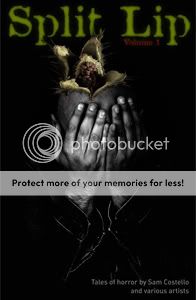
Split Lip Vol. 1
Sam Costello, writer
Josh Bivens, Diego Candia, Gary Crutchley, Nelson Evergreen, Ayhan Hayrula, Brian A. Laframboise, Iain Laurie, Sami Makkonen, Brian McGleenon, Felipe Sobreiro, Kyle Strahm, artists
Tent City, 2009
158 pages
$15
Read it and buy it at SplitLipComic.com
The back cover of this collection of astute horror writer and critic Sam Costello’s anthology webcomic reads in part, “Split Lip sheds traditional horror archetypes in favor of creating dark moods, original characters, and frightening experiences.” Of the three claims I think the first is the best supported. Somber and stark in almost every particular, from plotting to dialogue to his army of collaborators’ art, Costello’s comics quietly but relentlessly reinforce the simple fact that horror is about death. There’s a funereal sadness even in the less effective pieces here, a sense that the horror Costello’s interested in stems not so much from fright as from pessimism. After all, we’re all headed for our own down endings. So to me this offsets the lack of bona fide “frightening experiences”; contra the back cover blurb, I don’t even think that’s what these comics were even going for.
That said, the individual stories vary wildly not so much in quality–I never though “man, this is junk”–as in, like I implied above, effectiveness. Costello’s admirable reliance on the visuals to tell the key parts of his stories, in particular their climaxes or climactic twists, allows the work to rise and fall on how clearly his artists can tell the story, and on a couple of occasions the answer is “not very.” I was left flummoxed by what, exactly, happened at the end of the King-esque cornfield morality play “Straw Men” and the grim fairy tale “Fitcher’s Bird,” while crucial spatial shifts in “Not Sleeping Well,” “The Consequences of a Little Alone Time,” and “School Supplies” were inadequately contextualized. Moreover, stiff figurework on “Straw,” “Consequences,” and “The Executioner Is a Lonely Men” tends toward pulp-ifying fairly restrained writing and, to return to the blurb, mitigating against the originality of the characters. (Given my predilections, I’m tempted to suggest Costello try tapping artists with an out-and-out alternative flavor to them, but I don’t wanna armchair-quarterback this thing.) And on the rare occasion where Costello opts to do the heavy lifting himself, the Ciudad Juarez meets J-horror story “Mujer,” overnarration adds a layer of remove and does in a sense of the story as a living breathing thing.
But elsewhere the writing’s sharp as a knife. Whatever the shortcomings of its visually rushed ending, “Fitcher’s Bird” is kind of uncanny in how well it captures the dark dream logic of classic fairy tales and children’s stories, with their transformations, dismemberments, and ritualistic tasks that must be performed. And the art can shine as well as obscure: Kyle Strahm’s striking white-on-black work in the Western-horror fable “Headin’ South” radiates from the page with the power of agitprop and sets up a nifty negative-image punchline panel to boot. The best of the stories here, “The Tree of Remembrance,” combines strengths on both fronts. For Costello’s part, it’s his least “scary,” most straightforwardly melancholy piece, centered on a striking visual metaphor for the way memories of those we’ve lost can both haunt and heal. Aptly named artist Nelson Evergreen makes the best impression of any of the book’s visual contributors by making the most of Costello’s (according to the book’s supplemental material) uncharacteristically loose script in terms of layout and paneling–the story appears to drift to the ground just like leaves off the titular tree. But Evergreen really kills it with a pair of heartrendingly lovely images of the story’s elderly protagonist in the full bloom of her youth–ha, as I write this I’m listening to the lilting end section to My Bloody Valentine’s “What You Want,” and it’s pretty much the visual equivalent of that. And the pair unite for a starkly gruesome final panel that adds a welcome sour note to the sad sweetness of the proceedings up until that point. It takes a lot for a collaboration of this sort to work so effectively, so when it does it’s a treat, and it’s worth tuning in again to see how often Costello and his collaborators can recapture that moment.
Gossip Girl thoughts
December 3, 2009Not a lot of Gossip Girl thoughts this week, other than these:
* The Thanksgiving dinner was the ultimate Gossip Girl scene in that all the dialogue consisted solely of lies, accusations, and revelations. Plus, I loved watching all the players slowly coalesce. It was like an event comic.
* Vanessa’s mom is awesomely horrible. Bitching Vanessa out for using the woord “doorman,” labeling Thanksgiving a front for the food industry…just magnificent. She’s like what the South Park morons think all liberals are like.
* Chuck Bass, Voice of Morality. How wonderful is his transformation into the Cravated Crusader? I really want to watch him take down a crime boss.
* Rufus needs to learn that when using video chat, the other person can see you wincing.
* Good for Serena’s mom for telling her she’s not welcome there anymore. But I really feel for Serena–being a slut is how she expresses herself! Parents just don’t understand.
* Blair suddenly encouraging Serena to go with Trip? Whaaat? Boo to that. And Serena fails at being a heterosexual woman by choosing Trip over Nate. But don’t worry Nate, Chuck’s there to comfort you…the only way he knows how.
Carnival of souls
December 3, 2009* What’s the most depressing thing about my most likely not being able to make this weekend’s Brooklyn Comics and Graphics Festival? Mat Fucking Brinkman’s gonna be there, that’s what. And thus the Brinkman Bowie is lost to the ages.
* Today on Robot 6: When faced with a Reed/Lucasfilm alliance, Gareb Shamus turns the ship around; and I had a little convo with my pal Jim Gibbons, Dark Horse’s new PR guy.
* I feel like I’ve linked to these before, but really, is there ever a bad time to direct my readers to Aeron Alfrey’s drawings of creatures from Stephen King’s The Mist?
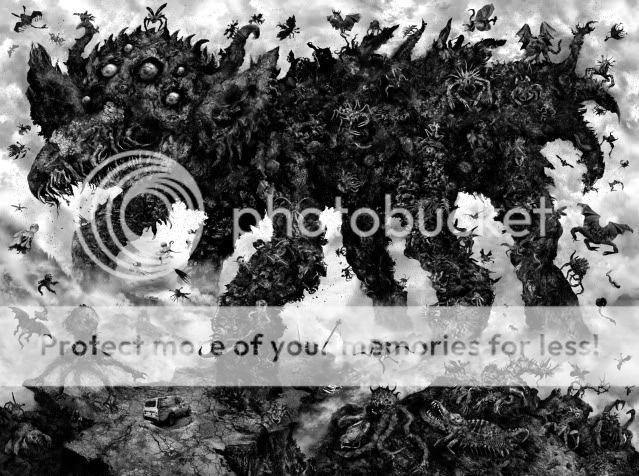
* I greatly enjoyed Rob Humanick’s heavily illustrated Best Films of the Decade list. That’s a gutsy Top 10 right there, man.
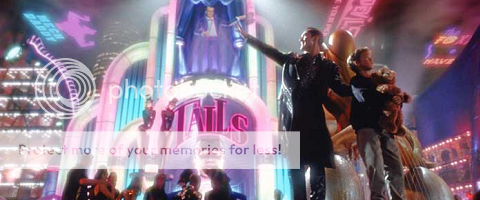
* As the years pass it’s difficult to remember just how noxious Britney Spears first seemed to music fans like me. Well, that’s not quite true–from the very first time I heard and saw the video for “Baby One More Time” I knew there was no arguing with its monstrous greatness. But as the Jesus Christ to the Spice Girls’ John the Baptist she represented the triumph of pop over all the music I really cared about, and it stunk. But today I can read something like Rich Juzwiak’s review of all her singles and B-sides and think “hey, that’s a pretty respectable body of work.” I mean, plenty of junk, but plenty of songs I enjoy hearing too. I never thought I’d comfortably say that but a lot has changed since 1998.
* GOD how I loved MUSCLE figures. Thank you, Topless Robot, for reminding me.

* Here are some truly, deeply horrifying stats on Americans’ support for torture, which is now at levels unheard of even in places like Iran. This is true: When your country has two major political parties and one of them has adopted support for torture as a plank, bad things happen.
* If you spend much time on the industry side of comics, you can probably understand the applicability of the Tiger Woods story–the real story, which is that Tiger’s real story was apparently known to but not covered by the sports journalism world for years. Which in some ways is as it should be, because I don’t think we need to go around panty-sniffing. But on the other hand, when a public figure who is also a major industry presents himself as one thing and the people whose job it is to cover that person know him to be something different…well, you wonder who else knows what else and isn’t telling. (Via Atrios.)
Comics Time: Image United #1
December 2, 2009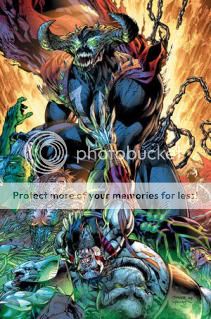
Image United #1
Robert Kirkman, writer
Erik Larsen, Rob Liefeld, Todd McFarlane, Whilce Portacio, Marc Silvestri, Jim Valentino, artists
Image, November 2009
24 pages
$3.99
Wowsers. So, uh, this is a jam comic by six of the seven Image founders, though Jim Lee makes a cameo by providing an alternate cover, which made me smile. It’s about some villains running amok and fighting various heroes for no apparent reason–that’s not my characterization of the plot, that’s the heroes’–which is a pretty fantastic encapsulation of the work of the Image founders to begin with, and certainly their work here. It’s all a moment-to-moment festival of sensation, gritted teeth and punching and blasting and charging the camera, without any kind of prologue or follow-through to place each physical action in any kind of spatial or temporal or emotional context, not even so much as a recap page to catch nostalgic readers up on characters they probably haven’t read since Nirvana was a going concern.
Entrusting layouts to Rob Liefeld (of the six they could have picked from, Liefeld!) could be said to be a mistake, in that characters like the narrator-hero Fortress or the uber-antagonist Omega Spawn burst onto the pages out of nowhere, like they teleported, even though they’re supposed to have been down the block or in the same room, but in light of the above it ends up fitting rather perfectly. At one point the big giant strong hero Badrock [sic] angrily threatens the big giant strong villain Overt-Kill [sic] over an attack we never see on a person who’s not even on panel at the time; later, the long-running Erik Larsen character Savage Dragon, whose appearance in a book filled to the brim with Silvestri and Liefeld creations feels like a walk-on by Glenn Ganges by comparison, remarks “I had no clue the girl took such a hit,” and I had to wonder if this wasn’t Kirkman having some deliberate fun. (I doubt having the arrow-based character Shaft repeat a balloon’s worth of dialogue verbatim two pages apart was deliberate, but wouldn’t it be aweome if it were?)
The most interesting thing about the project is that the artists don’t trade off sections, they draw their own characters whenever they appear, so that you can watch a Jim Valentino hero punch a Todd McFarlane villain, say. The problem with that, though, is that they’re simply not a terribly distinct collection of individual visual stylists. I mean, Larsen’s an exception of course, and Valentino doesn’t look like the rest of the gang but he doesn’t look like much of anything really, and McFarlane might stand out a little in terms of how he choreographs his characters’ physicality but there’s not much of that in this issue, so what you’re left with between Liefeld, Silvestri, Portacio, and McFarlane is a lot of squinty-eyed dudes and dudettes comprised of lots of tiny little lines, standing against generic secret base/rooftop/rubble backgrounds. There’s a manic energy to it, that’s undeniable, but it’s like an album-length guitar solo. It’s all extremely harmless and good-natured–it’s not going to upset you or offend you or leave a bad taste in your mouth, which is saying something–but it’s like being asked for your thoughts on a really rad comic drawn during study hall by the five coolest metalheads in the 9th grade, which not coincidentally is the last time I read comics by most of these guys. It’s all printed on paper stock so shiny it looks like a decade’s worth of gold-embossed chromium glow-in-the-dark holofoil covers were ground up and mixed into the pulp, like KISS’s blood or Mark Gruenwald’s ashes. I think everyone involved, from Kirkman to the Founders to the bulk of the book’s audience, got exactly what they wanted out of it.
Carnival of souls
December 1, 2009* I don’t really have a dog in the Twilight race other than a wife who enjoys it and my own tentative plans to watch New Moon again while under the influence, but I want to take a moment to praise the coverage of the franchise, and of similar projects like Kevin Williamson’s The Vampire Diaries tv show, by Dread Central. They’ve completely eschewed the kneejerk macho borderline-gaybaiting tone taken by the other major horror and geek news sites, and their coverage is all the better for it. (Particularly of TVD, which turns out to be a pretty ripping vampire yarn. Magic rings!)
* Dave Simpson’s profile of the Cocteau Twins’ Elizabeth Fraser for the Guardian is pretty extraordinary in that it simultaneously renews your faith in artists and crushes your hope for artistry. You don’t even need to be a big Cocteau Twins fan to get a lot out of the story of how Fraser’s break-up with her romantic and creative partner Robin Guthrie essentially drove her into artistic seclusion. It’s powerful stuff, and next time you hear “Teardrop” or “Song to the Siren” or “Pearly Dewdrops’ Drops” you’ll be haunted. (Via Matthew Perpetua.)
* The new Comics Journal website launched today, kinda sorta but not really.
* Chris Mautner tackles three recent releases from First Second.
* Bookmarking it for later until I get ahold of the book: Tom Spurgeon reviews Gilbert Hernandez’s The Troublemakers.
* The Maxx on DVD! Good.
* Paranormal Activity on DVD! Bad, because they’re saving the original ending for the Blu-Ray release only, same as they’re saving shitty old Terminator Salvation‘s director’s cut for the Blu-Ray only. I sort of resent being frogmarched into a new format if I wanna be a good nerd. (Via Jason Adams.)
* Go read Joe McCulloch’s post on manga and Manga, the least preachy and not coincidentally most convincing “ignore this stuff at your peril, comics readers” thing you’ll ever read.
* I know sweet fanny adams about the economics of hardcover and softcover collection release patterns from either a publisher or retailer perspective, but I nevertheless sympathize with this statement from Chris Butcher strictly as a person who buys superhero comics pretty much only in trade paperback and wants them to come out more quickly so I can purchase them in a timely fashion:
While I appreciate the short-term $$$ that comes from charging an extra $10 for a hardcover on a book, I think they’re really hurting long-term sales. I know that the whole superhero section of the industry seems to be predicated on short-term thinking, but I think that if it was about giving consumers choice simultaneous releases would be the way to go. This is a bit of a bigger problem than I have time to give it right now, but DC and Marvel mandating hardcover exclusives for 4-6 months means that their biggest, newest, ‘hottest’ storylines remain considerably more inaccessible until well after the heat has entirely dissipated on the series. The Justice Society relaunch is the hardest-hit series I can think of, but Green Lantern and Spider-Man and Runaways from Marvel are also suffering, from my POV, for having long gaps between HC and SC collections.
* Curt Purcell articulates a pretty convincing recipe for compelling event-comic tie-ins. The idea, which he’s expressed before, is that an event comics and its tie-ins are like a bank of tv monitors, and when the main action goes off in one direction, the tie-ins are what continues to play on the monitor the main action just left. The only flaw I see in this is that fans are conditioned to want “what matters,” i.e. what moves the plot forward. Filling in gaps isn’t their cup o’ meat. I suppose the key is to make the filling-in crucial to the sub-story going on in that particular tie-in series.
* Elsewhere, Curt elaborates his thoughts on Blackest Night #5, focusing on the physical portrayal of characters like the Flash and Nekron.
* A Matt Zoller Seitz video essay on Clint Eastwood and vengeance? Sure, I’ll eat it.
* I can’t wait until Habibi drops.
* I haven’t been linking to the previews of Johnny Ryan’s Prison Pit Vol. 2 that the Fantagraphics blog has been posting, but that’s not because they’re not totally awesome, as this supposedly final installment of the preview post series would indicate. Raise your game, New Actioneers!
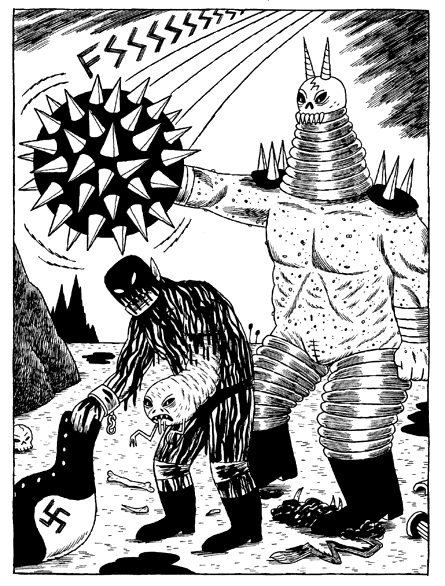
* Alltooflat maven Kennyb’s post on hammerhead sharks made me laugh to beat the band. I won’t spoil the punchline, but it does include this sentence:
what you’re seeing in this picture is a horrifying sea monster with a sixth sense for hearing the physical manifestation of your terror, and smell/taste receptors which are attuned to the scent of your blood in the water.
* Roland Emmerich vs. Lars Von Trier: Fight!

